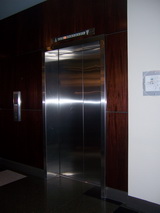History of Elevators
Elevators come in many different designs, types and sizes today but they were not always so unique. The history of elevators includes many earlier models that were very primitive in nature. The earliest elevators were used back in the 3rd century BC. These were lifts that were powered by water wheels, animals and/or humans. Power elevators did not actually come into existence until the nineteenth century and even then, they were mostly operated by steam. These steam elevators were used widely in many industries for moving materials within mines, factories and warehouses.
Elisha Otis
Elisha Otis first demonstrated a safer version of the freight elevator back in 1853. Otis was an inventor from America and designed an elevator that included a safety device that would prevent people from falling if the cable supporting the elevator were to break. This was a major breakthrough in elevator production and helped to increase the confidence that consumers had in elevators. The history of elevators since that time has significantly improved the look, overall design, operating method and safety features. By 1846 another inventor had produced a hydraulic lift that would power the elevator even easier and allow for lifting much more weight than ever before. The hydraulic elevators began seeing much more popularity over the years and by the end of the 1800s had all but completely replaced those powered by steam. Hydraulic elevators today, much like those of years past, are operated by oil or water in many cases that produce pressure and cause the device to lift. The elevator is supported by heavy pistons that move in a cylinder and cause the lifting action when in operation.
Electric Elevators
During the history of elevators, many power methods have come into play. Electric elevators are very common today but were among the last of the operating types to be produced. Electric elevators were first introduced during the end of the 1800s. The first electric elevator was created by Werner von Siemens, a German inventor. He introduced the first electric elevator model back in 1880.
How Elevators Work
Throughout the history of elevators many changes have been made to provide more weight capacity and better power options. Elevators typically work by raising and lowering the elevator cab using ropes that are made of wire and attached to the elevator car at one end. They are attached on the other end to a counterweight which allows the elevator car to be lifted and lowered accordingly. The counterweights add force when the car is lifting and help to stop the car at the appropriate levels. Metal weights are used to create the counterweights and guides are provided in the shaft to help keep the counterweights as well as the elevator car from being off balance. Elevators today are available in many different speeds and sizes but all use counterweights for balancing the elevator car as well as providing the lifting and lowering capabilities. Although they have changed drastically in design over the past few centuries, elevators are still basically the same technical design today as they were when the first was used.

